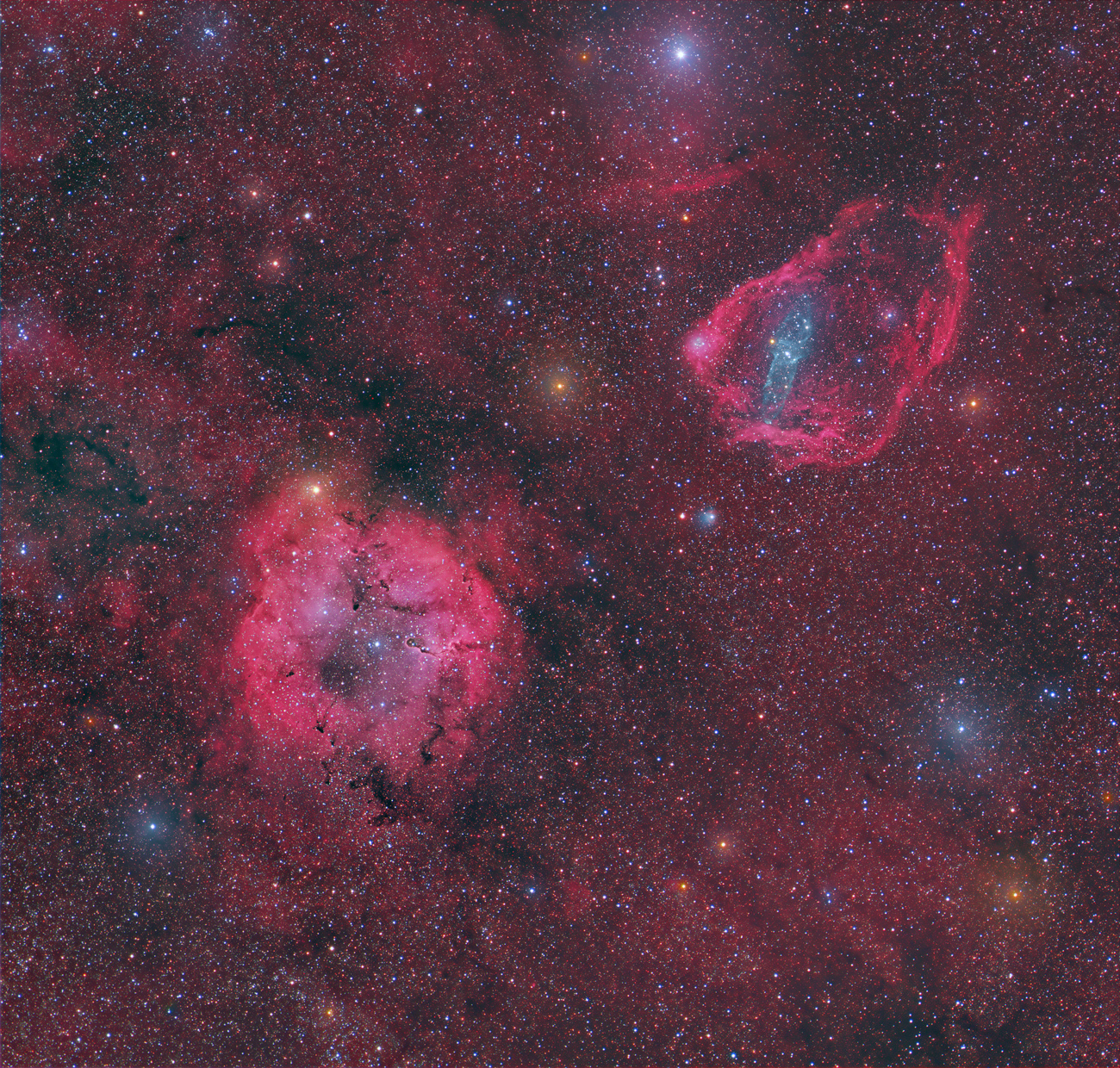Wide field view of IC1396 (with Elephant Trunk nebula) and
SH2-129 (Flying Bat nebula)
Characteristics:
RA: 21h 23m 50s (J2000)
Dec: 59degrees 09' 16" (J2000)
Description:
This is a composite of images taken over several years (2010, 2015,
2018), most recently using a 200mm Pentax lens attached to the U16M as
a widefield backdrop for IC1396 (lower left) and SH2-129 (upper
right).
IC1396 is a large emission nebula in Cepheus. Radiation
from the star HD206267 has
cleared out a central
portion from the nebula and has also blown away gas and dust radially,
resulting in a variety of dark globules that roughly point towards the
center. These are called "cometary globules"
in recognition of their overall shape, which consists of a head
followed by a tail of dust that is being blown backwards by HD206267's
solar wind. The most conspicuous globule is 1396A, also known as
the "Elephant Trunk,"
which contains a subtle reflection nebula vdb142.
Other cometary globules can be appreciated in the full frame
version of this image. Although
the dark gas and
dust are opaque to visible light, infrared light passes through this
region easily, permitting a view of the inner workings of the Elephant
Trunk. Please click here
for an infrared view of this area taken through the Space InfraRed
Telescope Facility (SIRTF), now known
as the Spitzer Space Telescope. Please be sure to check out
the larger sized images for greater detail. Rob
Gendler has an excellent
description of IC1396 on his website.
SH2-129
is a relatively faint emission nebula in Cepheus, a neighbor of the
larger and more often imaged IC 1396.
Sometimes referred to as the "Flying Bat" nebula, this region is
characterized by Ha emission as well as a small, mixed emission and
reflection nebula (vdB 140), seen in the lower portion of the field,
just to the left of center.
What is most remarkable about this region is a recent discovery made in
2011 by Nicolas
Outters, called the "Squid Nebula" due to its shape, but more
officially called Ou4. This region is characterized by a very
faint OIII emission that has a bipolar shape reminscent of a planetary
nebula, seen as the teal-colored region just to the left of center and
requiring 10 hours of imaging through an OIII filter to capture (and
could have used even more!). Although it was originally thought
to perhaps represent a planetary nebula derived from an unknown, dying
star, more recent
evidence suggests that Ou4 is located within SH2-129 itself and is
a
bipolar outflow emitting in the OIII spectrum, moving at the same rate
as SH2-129, and possibly emanating from a triple star system located in
the center of Ou4 (HR8119, visible above as the bright star in the
center of the Squid). More information about this region may be
found here.
Photographic
Details:
Dates: Pentax widefield: July 7,
2018 and August 10, 2018; IC1396: August 20, 26, 27, 28,
31 and September 1, 2010; SH2-129: August 25, 26, 27,
28,
2015
Scope: Pentax 200mm lens (2018); Takahashi
FSQ106 at f5 (2010 and 2015)
Autoguider: SBIG ST-402 with
60mm guidescope, focal length 227mm
Camera: Apogee U16M at -20C, with
7 position 50mm square filter wheel (Apogee FW50-7S)
Filters: Baader
RGB and Ha filters, 50mm square
Exposures: Pentax (2018): Ha, 3 hours; R, 1 hours; G, 1 hours; B, 1
hours, all unbinned. Please check links for IC1396 and
SH2-129
for additional exposure details
Post-processing:
Calibrated, aligned, and stacked in Maxim, followed
by DDP
in ImagesPlus (IP). Further processing in Photoshop CS (16
bit format)
Please
note: Graphics on this website
may not be reproduced without author permission.
Back to Nebulae
Home


